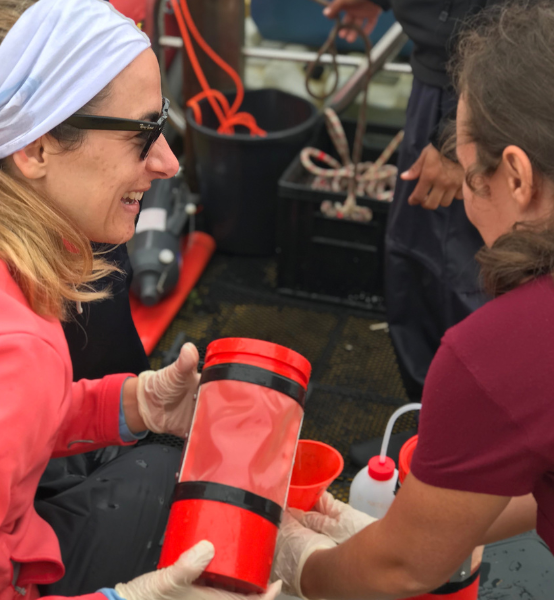WISE award for Eleonora Puccinelli
'The NWO Woman In Science Excel (WISE) Programme will support my tenure-track Principal Investigator position at NIOZ. My research interests and background revolve around benthic and pelagic ecology, with a strong focus on community and trophic ecology of low trophic level primary consumers across intertidal, offshore, and deep-sea environments. In my research I integrate ecological and biochemical expertise to understand the effects of climate change and other anthropogenic stressors on natural systems, and to generate the process knowledge needed to create and implement solutions to these threats,' says Puccinelli.

Main research line: Lipids and Omega-3 Fatty Acids in Marine Food Webs
The research centers on omega-3, long-chain polyunsaturated fatty acids crucial for human health, acquired through dietary intake. Small pelagic fishes serve as major sources of omega-3 for human consumption and remain key components in aquaculture feeds. The omega-3 content in fishes is influenced by the source of production and transfer efficiency from primary producers to higher trophic levels. Omega-3 in aquatic environments is predominantly produced by phytoplankton, varying among taxa. Nutrient-rich species (e.g., diatoms, dinophytes, haptophytes) exhibit high omega-3 levels, while species of poor food-quality (e.g., cyanobacteria) have low omega-3 concentrations. Simultaneously, the composition of a phytoplankton community depends on an amalgam of factors including the available nitrogen (N) source. Assimilation of one N form or the other (e.g., nitrate vs. ammonium) may lead to differences in the amount of omega-3 produced and thus on nutritional value of the phytoplankton, an effect that will be reflected in their consumers. In marine habitats, zooplankton (e.g., copepods and krill) in the open ocean, and filter-feeding macrozoobenthos (e.g., bivalves) in shallow coastal waters, serve as major primary consumers. Zooplankton and bivalves play pivotal roles as key trophic links between primary producers of omega-3 and various secondary consumers, including small pelagic fish and seabirds.

Projected Effects of Climate Change on Coastal Productivity and Food Webs
The Wadden Sea, designated as an UNESCO World Heritage Site, stands as the largest tidal flat system globally. This unique ecosystem features shallow-water coastal habitats that serve as crucial nursery and feeding grounds for both ecologically and commercially significant fishes. Additionally, it plays a vital role in supporting birds engaged in annual, long-distance migrations across hemispheres. This barrier island system, connected to the southern North Sea, is essential for population connectivity on various scales. It facilitates hemisphere-scale migrations of birds, regional life cycle closure in marine fishes, and sub-regional daily/tidal fluxes of predators feeding on macrozoobenthos.
Climate-driven warming has been associated with notable changes in the phenology, distribution, and interspecific interactions of species within the Wadden Sea. The system faces additional challenges from invasive species, land subsidence, fishing, and eutrophication. To address these multiple stressors effectively, a comprehensive understanding of their effects is crucial. This knowledge is integral to the development of conservation strategies, encompassing restoration, protection, and sustainable management.
Climate-driven changes in the availability of nutrients are projected for Eastern Boundary Upwelling Systems (EBUS), coastal systems covering 2% of the surface of the ocean but supporting 25% of the global fish catch. Upwelling events promote phytoplankton production through a succession of communities dominated known producers of high amount of omega-3 (e.g., diatoms). As such, these areas may represent hot-spot regions of omega-3 production. Climate change is projected to change wind stress altering the strength, frequency and spatial distribution of upwelling which is expected to modify the composition of phytoplankton communities reduce the omega-3 production by 30% globally and thus the stock of omega-3 available for humans.

From a broader perspective, the increasing stress on highly productive marine systems such as EBUS and in the Wadden Sea/North Sea from direct (e.g., pollution and/or habitat destruction) and indirect (climate change and related perturbations of ocean biogeochemistry) factors and processes will continue to alter marine biodiversity with repercussions for ecosystem functioning. A specific gap in knowledge exist on how omega-3 production in coastal systems will respond to climate-induced changes in physical and biogeochemical processes with limited information available on primary consumers such as zooplankton, especially in the Wadden Sea/North Sea.
Within this WISE, Puccinelli’s aim is to involve a PhD student who will work with her to develop new knowledge omega-3 production at present and the future accounting for climate variability.
About WISE
The Women In Science Excel (WISE) program offers talented female scientists the opportunity to set up or expand their own research group at one of NWO's research institutes. NWO believes in providing opportunities for all talented researchers to excel. As such, NWO is committed to improving the gender balance among its staff. WISE has contributed directly to attracting top female researchers and engineers and is promoting their career advancement.
